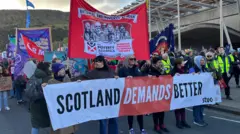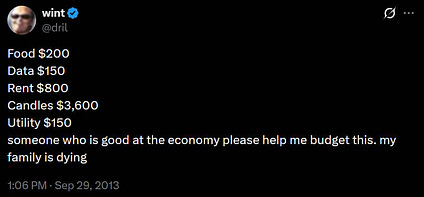Thousands march in Edinburgh calling for action to end poverty – BBC

Report on the ‘Scotland Demands Better’ Demonstration and its Alignment with Sustainable Development Goals
Introduction: Public Mobilisation for Sustainable Development
A large-scale demonstration, titled ‘Scotland Demands Better’, was held in central Edinburgh, organised by the Scottish Trades Union Congress (STUC) and The Poverty Alliance. The event saw thousands of participants, including trade union members, faith groups, and community organisations, march from the Scottish Parliament to the Meadows. The demonstration’s core objective was to advocate for decisive government action on poverty and social welfare, directly aligning with several key United Nations Sustainable Development Goals (SDGs), particularly ahead of the UK Budget and the forthcoming Scottish Parliament elections.
Core Demands and Linkage to Sustainable Development Goals (SDGs)
Addressing SDG 1 (No Poverty) and SDG 10 (Reduced Inequalities)
The primary focus of the demonstration was the urgent need to combat poverty, a direct call to action for SDG 1 (No Poverty). Recent research from The Poverty Alliance, indicating that one in four children in Scotland lives in poverty, underscores the critical nature of this issue. The protestors’ demands directly target mechanisms for poverty alleviation and inequality reduction, in line with SDG 10 (Reduced Inequalities).
- Abolition of the two-child benefit cap: A policy change aimed at providing adequate social protection for larger families, contributing to Target 1.3 (implement nationally appropriate social protection systems).
- Enhanced social security: A broader call for a more robust welfare system to protect vulnerable populations.
The Child Poverty (Scotland) Act 2017 established a target to reduce child poverty to 10% by 2030. However, with the current rate at 23%, the statutory interim target was missed, indicating a significant gap in achieving national goals aligned with SDG 1.
Advocating for SDG 8 (Decent Work and Economic Growth)
The demonstration highlighted the critical link between employment conditions and poverty. The call for “better jobs” and fair wages resonates with the principles of SDG 8 (Decent Work and Economic Growth). Specific concerns were raised by Unite union members regarding the potential closure of the Grangemouth refinery, which would result in the loss of highly skilled jobs and negatively impact local and national economic stability (Target 8.5: achieve full and productive employment and decent work for all).
Investment in Public Services and Infrastructure
Organisers articulated a need for increased investment in essential public services, which corresponds to multiple SDGs. These demands reflect a holistic approach to well-being and sustainable community development.
- Housing and Transport: Calls for investment in affordable housing and accessible transport align with SDG 11 (Sustainable Cities and Communities), specifically Target 11.1 on ensuring access to adequate and safe housing.
- Healthcare: The demand for better-funded healthcare supports SDG 3 (Good Health and Well-being), as poverty is a key social determinant of health.
- Education and Childcare: The specific request for increases in free childcare directly supports SDG 4 (Quality Education), particularly Target 4.2, which aims to ensure access to quality early childhood development and pre-primary education.
Governmental Response and Policy Context
Statements from Scottish and UK Governments
In response to the demonstration, First Minister John Swinney acknowledged the unacceptability of the current poverty levels in Scotland. The UK government spokesperson highlighted ongoing efforts to combat poverty, including increases in the national minimum wage and changes to universal credit, and confirmed a strategy to tackle child poverty will be published later this year. These statements reflect governmental recognition of the challenges in meeting national and international commitments related to the SDGs.
Analysis of Sustainable Development Goals in the Article
1. Which SDGs are addressed or connected to the issues highlighted in the article?
The article highlights several interconnected issues primarily centered around poverty and social welfare in Scotland. Based on the demands of the protestors and the context provided, the following Sustainable Development Goals (SDGs) are addressed:
- SDG 1: No Poverty – This is the central theme of the article, with the entire demonstration focused on calling for more action to tackle poverty, specifically child poverty.
- SDG 2: Zero Hunger – The article explicitly mentions the consequences of poverty, stating, “Too many of us are going hungry, or are… sacrificing meals to feed their children.”
- SDG 3: Good Health and Well-being – Protestors demand more investment in “life essentials” which explicitly includes “healthcare.”
- SDG 4: Quality Education – The call for investment in “education” and “increases in free childcare” directly relates to this goal. A banner in an image also reads “Stand Up for Education.”
- SDG 8: Decent Work and Economic Growth – The demonstration is part of a campaign for “better jobs,” and speakers raise concerns about the loss of “highly skilled jobs” and “wages that don’t cover their household costs.”
- SDG 10: Reduced Inequalities – The focus on poverty, the specific call to scrap the “two child benefit cap,” and the general demand for better social security aim to reduce economic and social inequalities.
- SDG 11: Sustainable Cities and Communities – The article notes that protestors want to see more investment in “life essentials” such as “housing” and “transport,” and a speaker states that “decent affordable housing remains out of reach.”
2. What specific targets under those SDGs can be identified based on the article’s content?
Several specific SDG targets can be identified from the issues and demands described in the article:
- Target 1.2: By 2030, reduce at least by half the proportion of men, women and children of all ages living in poverty in all its dimensions according to national definitions. The article is directly aligned with this target by discussing the Child Poverty (Scotland) Act 2017, which set national targets “to cut child poverty to 18% by 2024/25 and 10% by 2030/31.”
- Target 1.3: Implement nationally appropriate social protection systems and measures for all. The demands for “better jobs and social security,” “increases in free childcare,” and “scrapping the two child benefit cap” are calls to strengthen social protection systems.
- Target 2.1: By 2030, end hunger and ensure access by all people, in particular the poor and people in vulnerable situations, including infants, to safe, nutritious and sufficient food all year round. The statement that people are “going hungry” or “sacrificing meals” directly relates to the challenge of ensuring access to sufficient food.
- Target 4.2: By 2030, ensure that all girls and boys have access to quality early childhood development, care and pre-primary education so that they are ready for primary education. The specific call for “increases in free childcare” supports this target.
- Target 8.5: By 2030, achieve full and productive employment and decent work for all women and men… and equal pay for work of equal value. The campaign for “better jobs” and the concern that “wages and living standards just aren’t keeping up” reflect the core aims of this target.
- Target 10.4: Adopt policies, especially fiscal, wage and social protection policies, and progressively achieve greater equality. The protestors’ demands for changes to the benefit system (scrapping the two-child cap) and better wages are direct calls for policies that would reduce inequality.
- Target 11.1: By 2030, ensure access for all to adequate, safe and affordable housing and basic services. This is addressed by the demand for more investment in “housing” and the comment that “decent affordable housing remains out of reach.”
3. Are there any indicators mentioned or implied in the article that can be used to measure progress towards the identified targets?
The article explicitly and implicitly refers to several indicators that can be used to measure progress:
- Indicator 1.2.2 (Proportion of population living below the national poverty line, by sex and age): The article provides very specific data points for this indicator. It states that “one in four children in Scotland is living in poverty,” that the Scottish government missed its interim target to reduce the rate below 18%, with “the figure left at 23%,” and that the 2030/31 target is 10%. These percentages are direct measurements of child poverty according to a national definition.
- Indicator 1.3.1 (Proportion of population covered by social protection floors/systems): This is implied through the discussion of social security measures. The existence and scope of policies like “free childcare” and the “two child benefit cap” serve as indicators of the social protection system’s reach and adequacy.
- Indicator 8.5.1 (Average hourly earnings of female and male employees, by occupation, age and persons with disabilities): This is implied by the statement that people are “struggling to get by on wages that don’t cover their household costs.” The relationship between wages, such as the “national minimum wage” mentioned, and the cost of living is a key measure of decent work.
- Indicator 11.1.1 (Proportion of urban population living in slums, informal settlements or inadequate housing): The statement that “decent affordable housing remains out of reach” implies a lack of adequate housing. The affordability and availability of housing would be the key indicators to measure progress on this front.
4. SDGs, Targets, and Indicators Summary
| SDGs | Targets | Indicators (Mentioned or Implied in the Article) |
|---|---|---|
| SDG 1: No Poverty | 1.2: Reduce poverty according to national definitions. 1.3: Implement social protection systems. |
Proportion of children living in poverty (stated as “one in four” or 23%, with targets of 18% and 10%). Coverage and adequacy of social protection policies like “free childcare” and the “two child benefit cap.” |
| SDG 2: Zero Hunger | 2.1: End hunger and ensure access to food. | Prevalence of food insecurity (implied by people “going hungry” or “sacrificing meals”). |
| SDG 4: Quality Education | 4.2: Ensure access to quality early childhood development and care. | Access to and provision of “free childcare.” |
| SDG 8: Decent Work and Economic Growth | 8.5: Achieve full employment and decent work for all. | Level of wages relative to living costs (implied by “wages that don’t cover their household costs”). The level of the “national minimum wage.” |
| SDG 10: Reduced Inequalities | 10.4: Adopt fiscal, wage, and social protection policies to achieve equality. | Existence of policies affecting inequality, such as the “two child benefit cap.” |
| SDG 11: Sustainable Cities and Communities | 11.1: Ensure access to adequate and affordable housing. | Availability and affordability of housing (implied by “decent affordable housing remains out of reach”). |
Source: bbc.com
What is Your Reaction?
 Like
0
Like
0
 Dislike
0
Dislike
0
 Love
0
Love
0
 Funny
0
Funny
0
 Angry
0
Angry
0
 Sad
0
Sad
0
 Wow
0
Wow
0


















































.jpg.webp?itok=0ZsAnae9#)





/environment-climate-change-and-health-(ech)/water-sanitation-hygiene-and-health-(wsh)/landfill-tuvalu-36092.tmb-1200v.jpg?sfvrsn=5c21fe40_1#)



















